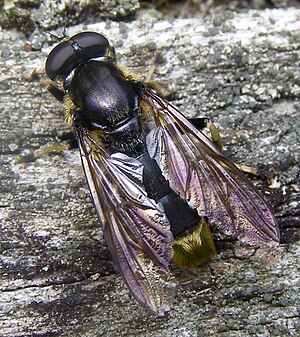Golden hair long-bellied hover fly
| Golden hair long-bellied hover fly | ||||||||||||
|---|---|---|---|---|---|---|---|---|---|---|---|---|

Golden-haired long-bellied hover fly ( Xylota sylvarum ) |
||||||||||||
| Systematics | ||||||||||||
|
||||||||||||
| Scientific name | ||||||||||||
| Xylota sylvarum | ||||||||||||
| ( Linnaeus , 1758) |
The golden-haired long-bellied hover fly ( Xylota sylvarum ) is a fly from the family of hover flies (Syrphidae).
features
The flies have a body length of 12 to 16 millimeters. Their mesonotum is colored metallic black and has short, light hair. The abdomen is also shiny metallic, but has a blue-black basic color. The third and fourth abdominal segments are basal with dense golden yellow hair. The second and third abdominal segments can have pale gray spots. The rails ( tibia ) are dark on the distal half. The thighs ( femora ) are black. The males have two small teeth on each of the thigh rings ( trochanters ) on their rear legs . The forehead and face are dusted yellow. The forehead of the females is very narrow, has a shiny blue-black base color and yellow side spots. The first two parts of the antennae are black, the third is brown. The species can be confused with other species of its genus. The very similar Xylota xanthocnema differs in its completely yellow colored splints and is also somewhat smaller.
Occurrence and habitat
The species is distributed from Fennoscandia south to the Iberian Peninsula and from Ireland east over large parts of northern and central Asia to the Pacific coast. In southern Europe it is common in Italy, the states of the former Yugoslavia, Greece and Turkey. The species lives in forests, with most species being populated by damp deciduous and coniferous forests with old and overaged trees and also holm oak forests along rivers. It occurs widespread in Central Europe and is common locally.
Way of life
The adults fly from late May to September, with the peak in July. They can be found on roadsides and on the edge of clearings and sit on the leaves of bushes, bracken ( Pteridium ) and on low-growing vegetation; sometimes on tree stumps. They fly to the flowers of buttercups ( Ranunculus ) and raspberries ( Rubus idaeus ). The majority of the pollen consumed for nutrition comes directly from the surface of leaves and partly from the excretions of other hoverflies. Like Xylota lenta , the males defend their territory against intruders.
The larvae live in damp, fungal dead wood of firs ( Abies ), beeches ( Fagus ), oaks ( Quercus ), pines ( Picea ), ash trees ( Fraxinus ), aspen ( Populus tremula ) and Douglas firs ( Pseudotsuga ). They are found in trunks, stumps and roots, usually below the bark. They can also be found in damp sawdust. They feed saprophagous on dead, organic substances.
supporting documents
Individual evidence
- ↑ Gerald Bothe: Hoverflies. German Youth Association for Nature Observation, Hamburg 1996.
- ↑ a b c Kurt Kormann: Hover flies and bubble-head flies of Central Europe (= Fauna-Naturführer . Volume 1 ). 1st edition. Fauna, Nottuln 2003, ISBN 3-935980-29-9 , p. 172 .
- ↑ a b c Golden-haired long-bellied hover fly - Xylota sylvarum (LINNAEUS, 1758). www.natur-in-nrw.de, accessed on May 3, 2015 .
- ↑ a b c M.CDSpeight: Species accounts of European Syrphidae (Diptera), 2012. Syrph the Net, the database of European Syrphidae, vol. 69, Syrph the Net publications, Dublin 2012.
literature
- Gerald Bothe: Hoverflies. 8th revised edition. German Youth Association for Nature Observation, Hamburg 1996, ISBN 3-923376-07-3 .
- Kurt Kormann: Hover flies and bubble head flies of Central Europe (= Fauna-Naturführer . Volume 1 ). 1st edition. Fauna, Nottuln 2003, ISBN 3-935980-29-9 .
Web links
- Xylota sylvarum in Fauna Europaea. Retrieved May 3, 2015